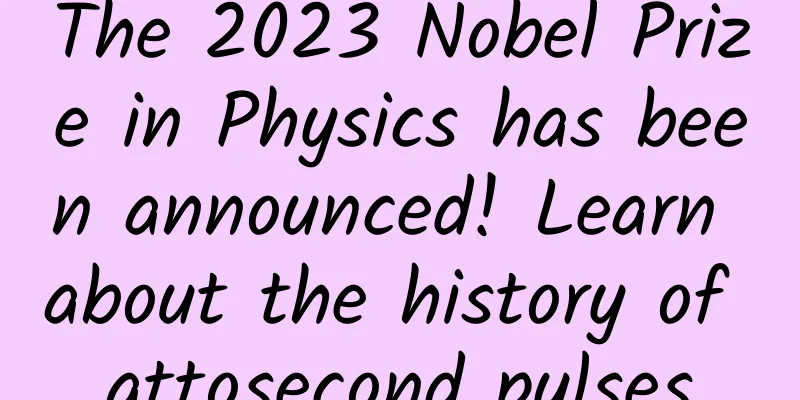The 2023 Nobel Prize in Physics has been announced! Learn about the history of attosecond pulses

|
The 2023 Nobel Prize in Physics was awarded to three physicists in the field of attosecond lasers, who have brought us new tools to explore the microscopic world. How did humans break through the shortest pulse step by step? Let's take a look at its past and present. Light is one of the most important physical phenomena. A flash process can be described as a light pulse. For coherent light, since the spectral components (light of different colors) it contains are coherent and the phase difference of each component is fixed, pulse modulation and compression can be achieved to obtain coherent light pulses with extremely short duration, breaking through the limitations of mechanical and electronic shutters and becoming a real carrier for creating the ultimate physical time scale. In 1960, Theodore Harold "Ted" Maiman (1927–2007), a physicist at Hughes Laboratory under Hughes Aircraft Company, built the world's first coherent light source - a flash lamp-pumped ruby (chromium-doped aluminum oxide crystal) laser with an output wavelength of 694.3 nanometers. This is the simplest parallel plane cavity single-frequency (monochromatic) laser with a pulse width in the microsecond range. The importance of this laser lies in the fact that it is a brand new light source based on a completely different physical process, and its coherence is not possessed by Edison's tungsten filament bulb. Although lasers were called "a solution looking for a problem" when they first appeared, they soon became ubiquitous, from scientific research, industry and military to communications, entertainment and art, as well as our daily lives - there is at least one laser in your DVD player, and the machine that scans the barcode of goods at the supermarket checkout counter is also a laser. As soon as the laser appeared, people were eager to shorten the pulse. On the one hand, it was due to the interest in studying ultrafast phenomena, and on the other hand, it was the pursuit of high peak power. Under the condition of the same average power, the shorter the pulse, the higher the peak power. In the 1970s, people achieved the laser pulse width of picoseconds. In the 1980s, with the emergence of titanium sapphire as a laser medium, as well as Kerr lens mode locking and chirped pulse amplification technologies, people not only obtained femtosecond laser pulses, but also effectively amplified the pulse energy. Up to now, titanium sapphire oscillators can obtain output with a pulse width of less than 5 femtoseconds, and amplifiers can output energy exceeding 330 joules, with a pulse width of 21 femtoseconds after compression, so that the peak power exceeds 10 petawatts (petawatt = 1015 watts) (Shanghai Institute of Optics and Fine Mechanics in 2017). In comparison, the total installed capacity (maximum output power) of the Three Gorges Hydropower Station is 22.4 million kilowatts (2.24×1010 watts). In other words, the peak power of the laser can be about 50,000 times the maximum output power of the Three Gorges Hydropower Station. Such ultrashort laser pulses provide us with a flashlight that can be used to observe particles in the microscopic world. If we use a detector to record a series of phenomena corresponding to the microscopic state or particle motion of each pulse in a series of laser pulses, such as spectrum, absorption, fluorescence, particle momentum or energy, it is equivalent to taking a series of high-speed photographs of them. We can observe microscopic state changes or particle motion through these photos to study phenomena in the microscopic world. In terms of time scale, the vibration of the crystal lattice, chemical reactions, or the rotation of molecules in the crystal corresponds to picoseconds or longer, which can be observed with picosecond laser pulses; the vibration of chemical bonds or small molecules occurs in the femtosecond order; and faster electron motion requires attosecond pulses to resolve. Modern ultrafast optics based on pulsed lasers has developed along this trajectory. Figure 1: Time scale of microscopic motion. Most of the physical (and chemical) phenomena we encounter in our daily lives, apart from the gravitational (gravitational) effect, are based on electromagnetic interactions. For example, electron-phonon scattering, plasmons, and superconducting phase transitions in solids; electronic transitions and ionization in atoms and molecules; the breaking and formation of chemical bonds in chemical and biological reactions; especially the interaction between light and matter, such as the photoelectric effect, various absorptions and radiations, including the laser itself; and so on. The ultimate physical basis of these phenomena is the interaction and movement of charged particles. Electrons are the smallest of the common charged particles, three orders of magnitude smaller than protons or atomic nuclei. Therefore, in physical processes, the response speed of electrons is much faster than that of atoms, molecules, and lattice structures; this is why electron motion and electron correlation are the most basic and core physical processes in multi-electron systems. The lattice and molecular motion we observe at the picosecond or femtosecond scale actually occurs after the motion of electrons and is the result of electron motion. Just like when we see flags waving on the city wall, we think it is the flags that are moving, but it is actually the wind that is moving. Electrons are the wind that blows the flags, and they are the first to respond in electromagnetic interactions and the reason that drives other movements. For example, in the decomposition process of diatomic molecules, first the outer electrons absorb photons and jump to an unstable high-energy state; then this transition causes the two atoms in the molecule to move in opposite directions and finally separate. Therefore, in order to truly understand these physical phenomena, it is necessary to study the ultrafast movement of electrons. However, the time scale of electron motion is attoseconds, which is faster than femtoseconds. The fastest existing femtosecond pulses (about 0.5 to 1.5 femtoseconds) have a spectrum that covers the infrared to ultraviolet bands. Since the characteristics, methods and technologies of the generation, propagation, dispersion and compensation of each light band from infrared to visible to ultraviolet are very different, it is technically almost impossible to further broaden the spectrum as the center in order to obtain coherent light pulses as short as 0.1 femtoseconds (100 attoseconds). From another perspective, the light period of the central wavelength in the visible to near-infrared band is about 1 to 3 femtoseconds, and a pulse of 0.1 femtoseconds means a pulse of one-tenth of the period, which is also almost impossible to achieve. The only way is to move the entire spectrum to the short-wave direction to the deep ultraviolet or even the X-ray band. Figure 2: Typical high-order harmonic spectrum This is actually not easy. The shorter the wavelength, the higher the corresponding photon energy. Common electrons or vibration energy levels in atoms can no longer meet the requirements as laser transition energy levels. At the same time, high-energy electrons in plasmas or oscillators are difficult and expensive to use as light amplification media. Therefore, the solution still depends on existing ultrafast lasers. As the energy of the laser pulse increases, after optical focusing, the power density at the focus, that is, the electric field strength, gradually increases to a level comparable to the Coulomb field that binds electrons inside the atom. Under these conditions, electrons can break free from the constraints of the nucleus and enter a free state, which is ionization. In 1963, shortly after the advent of lasers, EK Damon and RG Tomlinson of Ohio State University and RG Meyerand, Jr. and AF Haught of the Joint Spacecraft Laboratory used ruby lasers to conduct experiments on gas ionization. In 1965, LV Keldysh of the Lebedev Physical Institute of the Soviet Academy of Sciences proposed the theory of tunneling ionization. Tunneling means that electrons escape from atoms as if passing through a tunnel. In 1979, P. Agostini and others at the Sackler Center in France observed the phenomenon of above-threshold ionization. Above-threshold ionization means that the energy of the ionized electrons is equivalent to several to dozens of times the energy of the laser photons. With the development of lasers, these works have developed into the field of strong field ionization, which specializes in studying various phenomena of atomic and molecular ionization in strong laser fields. By 1988, M. Ferray, A. L'Huillier and others from the French Institute of Atomic and Surface Physics observed that the high-order harmonic spectrum produced when strong lasers irradiate atoms is a series of comb-shaped spikes, and the photon energy in each spike is several times or even dozens of times the energy of the laser photon; the difference between adjacent spikes is usually two laser photon energies. This is called high-order harmonics in lasers. The wavelength of the most commonly used titanium sapphire femtosecond laser is 800 nanometers, the period of light wave oscillation is 2.67 femtoseconds, and the corresponding photon energy is 1.55 electron volts (eV); the photon energy of its 65th harmonic is 100 electron volts, and the wavelength is 12.4 nanometers, which is close to the shortest wavelength of ultraviolet light (10-400 nanometers), called the extreme ultraviolet band (XUV), and the corresponding light wave oscillation period is only 41 attoseconds, which is the ideal band for generating attosecond pulses! Figure 3: Three-step model of attosecond pulse generation. (A) Coulomb field of an atom and the electrons in it; (B) Tunneling ionization occurs under the action of a strong laser field, and the electrons leave the atom; (C) The electrons that leave the atom are accelerated in the strong laser field and gain energy; (D) The electrons return to the atom, and the energy gained in the laser field is released in the form of an extreme ultraviolet photon. In fact, as early as 1987, M. Yu. Kuchiev of the Ioffe Institute of Physics and Technology of the Soviet Academy of Sciences proposed a two-step model of secondary scattering of outer electrons of atoms after ionization in the laser field to explain why the energy of photoelectrons produced by above-threshold ionization is so high. In 1993, KJ Schafer, B. Yang, LI DiMauro and KC Kulander of Lawrence Livermore and Brookhaven National Laboratory in the United States also proposed a two-step model of multiple scattering, which is the initial ionization and acceleration of electrons in the laser field. Since the laser field is an alternating electric field, when the direction of the electric field changes, the electrons may fly back to the vicinity of the ionized atoms (ions). Based on this, they explained both above-threshold ionization and high-order harmonics. Later in the same year, PB Corkum of the Canadian National Research Council elaborated on the semiclassical three-step model of strong field ionization. The first two steps were still ionization and acceleration of electrons in the laser field. Due to the acceleration effect of the laser field, the electrons carried very high energy. The third step explained three closely related phenomena. One is double electron ionization, which means that when the first ionized electron returns to the vicinity of the ion, it knocks out a second electron. The second type is elastic scattering, which is actually above-threshold ionization. The ionized electrons do not exchange energy with the ions again, which also explains the high-energy above-threshold ionization. The third type is that electrons and ions combine to form atoms, and the energy carried by the electrons is converted into a photon and released, which is a high-order harmonic photon. When we bombard inert gas with femtosecond laser, the three-step process of ionization-acceleration-recombination with ions occurs once in each half-cycle of the laser, and a large number of high-order harmonic photons radiated by the atoms involved in the reaction form a light pulse. Since the half-cycle of the femtosecond laser is one to several femtoseconds, and the spectrum of the extreme ultraviolet band can support ultrashort pulses, the high-order harmonic light pulses generated reach the sub-femtosecond or attosecond time scale. The commonly used femtosecond laser pulses contain several to dozens of light cycles, which will produce several to dozens of attosecond pulses. When we observe the spectrum, this string of attosecond pulses undergoes spectral interference, forming a comb-shaped high-order harmonic spectrum. The three-step model explains this series of physical phenomena, especially high-order harmonics, and outlines a complete and intuitive physical image, becoming the original theoretical basis for high-order harmonics and attosecond optics. Due to the importance of isolated attosecond pulses (each laser pulse only produces one attosecond pulse rather than a string of pulses corresponding to high-order harmonics) for ultrafast measurements, Corkum, NH Burnett, and MY Ivanov proposed the theory and method of extracting an isolated attosecond light pulse from a high-order harmonic attosecond pulse string the following year. Since then, the curtain has been raised on attosecond optics! Figure 4: Pulse width of attosecond pulses changes over the year. 43 attoseconds is the new world record for the shortest coherent light pulse. It should be said that in the last few years of the 20th century, people had already made it clear that high-order harmonics were a series of attosecond pulses, but it was not until a few years later in the 21st century that the pulse width was actually measured in experiments, thus confirming the attosecond result. In 2001, the Sackler Center and the National Center for Advanced Technology in France, together with HG Muller and others from the Institute of Atomic and Molecular Physics in the Netherlands, first used a 40-femtosecond titanium sapphire laser to bombard argon gas to produce high-order harmonics of the 13th to 19th order, and measured a pulse train with a single pulse width of 250 attoseconds. In the same year, F. Krausz's group at the Vienna University of Technology in Austria, in collaboration with Corkum and Bielefeld University in Germany, used a 7-femtosecond laser pulse output by a titanium sapphire laser through a nonlinear compressor to generate high-order harmonics in neon gas and selected a spectrum with a photon energy of about 90 electron volts (wavelength of about 14 nanometers). The measurement results showed that this was a pulse of about 600 attoseconds. In 2004, Krausz's group used a 5-femtosecond drive laser combined with an attosecond streak camera to measure an isolated pulse with a pulse width of 250 attoseconds. These experiments finally broke through the femtosecond boundary and pushed people's capabilities in ultrashort laser pulses and ultrafast optical research to the attosecond level. In 2006, M. Nisoli's group at the Italian National Laboratory for Ultrafast and Ultraintense Optics further shortened the pulse width to 130 attoseconds. In 2008, the Krausz group, which had moved to the Max Planck Institute for Quantum Optics in Germany and the University of Munich, obtained an isolated pulse of 80 attoseconds. In 2012, Professor Zenghu Chang's group at the University of Central Florida in the United States obtained an isolated pulse of 67 attoseconds, with a central photon energy of 90 electron volts and a full spectrum covering 55 to 130 electron volts (wavelength 22 to 9.5 nanometers). In 2013, the group of Researcher Zhiyi Wei at the Institute of Physics, Chinese Academy of Sciences, obtained an isolated pulse of 160 attoseconds using a 3.8 femtosecond drive pulse, which is the only experimental result of attosecond pulses in China. After the 67 attosecond result maintained the world record for 5 years, the research groups of Professor Zenghu Chang of the United States and HJ Wörner of the Swiss Federal Institute of Technology in Zurich reported shorter pulses at the 6th International Attosecond Physics Conference hosted by the Institute of Physics of the Chinese Academy of Sciences in Xi'an in July 2017. After that, Professor Chang's group published a formal paper in August. They used an infrared laser with a pulse width of 12 femtoseconds and a central wavelength of 1.7 microns as the driving light source to obtain an isolated pulse of 53 attoseconds, with a central photon energy of 170 electron volts (wavelength of 7.3 nanometers), which refreshed their previous world record and for the first time raised the photon energy of attosecond pulses to more than 100 electron volts. In the paper published by the Swiss group two months later, they used a similar driving light source as Professor Chang's research group, but the pulse energy was lower, so the central energy of the attosecond pulse generated was only 100 electron volts, but its spectral shape was better, and the pulse width was only 43 attoseconds, becoming the latest world record for coherent light pulses! Attoseconds are the shortest time scale currently mastered by humans. One attosecond is equivalent to one second in the lifetime of the universe. At present, the attosecond pulses that can be achieved in the laboratory are on the order of 100 attoseconds. If it is further advanced to 10 attoseconds, it should be fully capable of studying the ultrafast motion of electrons. For physical phenomena based on electromagnetic interactions, 10 attoseconds can probably be regarded as the ultimate ultrafast time indicator! The advancement of coherent light pulses from femtoseconds to attoseconds is not just a simple advancement in time scale. More importantly, it has advanced people's ability to study the structure of matter from the movement of atoms and molecules to the interior of atoms. It can detect the movement and correlation of electrons, thus triggering a major revolution in basic physics research. Precisely measuring the movement of electrons, understanding their physical properties, and then controlling the dynamic behavior of electrons in atoms is one of the important scientific goals that people pursue. With attosecond pulses, we can measure and even manipulate individual microscopic particles, and then make more basic and principled observations and descriptions of the microscopic world, a world dominated by quantum mechanics. For example, we can use attosecond pulses to track electrons in chemical reactions to understand and even manipulate the progress of reactions. We can also carefully observe electrons in photovoltaic cells and nanostructures to find more efficient solar cells and stronger nanofibers. Or we can use attosecond lasers to measure electron pairs in superconductors to find the key to unlock the secrets of superconductivity. If we have an attosecond laser "tweezers", then storing and manipulating electrons and photons in quantum computers may become a dream come true. A similar pair of "tweezers" can also be used to analyze the structure and behavior of DNA and proteins, or to put drugs into diseased cells, so that cancer and other difficult and complicated diseases may be cured. Attosecond optics will gradually expand to attosecond physics, attosecond chemistry, attosecond electronics, and so on. However, one of the biggest problems in attosecond optics is that attosecond pulses are very low in energy. The femtosecond laser pulses commonly used in laboratories contain about 10 trillion (1016) photons, but the attosecond pulses produced only contain about 10 million (107) photons. Such pulses are not only unable to produce nonlinear optical effects or stimulate even the lowest-order multiphoton processes such as two-photon ionization, but also face the problems of long integration time and low signal-to-noise ratio even in experiments involving spectroscopy or photoelectron measurements in the field of linear optics. Based on the development prospects of attosecond optics and the importance of high-energy attosecond pulses, my country's Ministry of Science and Technology, the National Natural Science Foundation of China, and the Chinese Academy of Sciences have invested key funds to carry out research work. The Ministry of Science and Technology launched this year's national key research and development plan "Key Technologies for Ultrashort Pulse, Single-Frequency and Mid-Infrared Laser Materials and Devices" project includes the topic "Research on Key Technologies for High-Throughput Attosecond Laser Devices and Advanced Driving Sources", which aims to study and explore theoretical and technical methods for obtaining high-energy attosecond pulses, while promoting the extensive development of cutting-edge research in attosecond optics in China and promoting the widespread application of attosecond optics in various scientific research fields. The development of these studies will not only give us the opportunity to have a deeper understanding of the generation process of attosecond pulses, but higher pulse energy can also promote attosecond pulses to become ultrafast light sources with more diverse functions and wider application fields! Planning and production Source: Institute of Physics, Chinese Academy of Sciences Original title: "2023 Physics Nobel Prize: The Past and Present of Attosecond Pulses" Author: Zhao Kun and Wei Zhiyi (Key Laboratory of Optical Physics, Institute of Physics, Chinese Academy of Sciences) Editor: Yinuo |
>>: Ecological farm, the “green card” of agricultural development
Recommend
3 fission techniques to quickly acquire customers at low cost!
Since 2017, online traffic has become more and mo...
Mobile networks are killing Wi-Fi, survey shows
According to foreign media reports, recently, Man...
An ancestral precept has governed the country for 600 years. This "pearl" in the vast forest of northern Fujian is creating an ecological miracle.
Wanmulin Nature Reserve in Jianou City, Fujian Pr...
Single window day 15-20, the latest PG assistant mini game hang up wool project
Single window day 15-20, the latest PG assistant ...
Hurun released the list of China's top ten unicorns, and Aion is the only electric vehicle manufacturer selected
Hurun released the list of China's top ten un...
The August marketing promotion activities guide is here!
From the August marketing calendar, we can see th...
Is there any pattern in the arrangement of galaxies, fractal or random?
Where do galaxies change and is there any pattern...
Exploring the Secrets of World Navigation丨Western "Latitude and Longitude Positioning" Navigation Technique
Sailed with Columbus and Magellan Travel through ...
Debate: Is Yang Yuanqing a qualified Lenovo CEO?
An article in a certain self-media titled "T...
Why is bidding promotion ineffective? Just read this article | How to improve promotion effectiveness?
The low conversion rate of SEM promotion is a com...
9 relatively practical WeChat group tips, the last one is little known
1. Create a group with only yourself Sometimes we...
Why can’t I spend my money on bidding ads such as information flow ads?
I believe that friends who have placed informatio...
Li Xiaoyue's Xiaohongshu full-level short video training camp, 30-day community training camp
Li Xiaoyue's Xiaohongshu full-level short vid...
Xiaohongshu operation and promotion: user operation model and monetization!
I went to Hong Kong during the May Day holiday. I...









